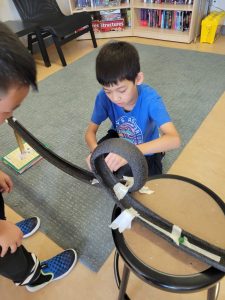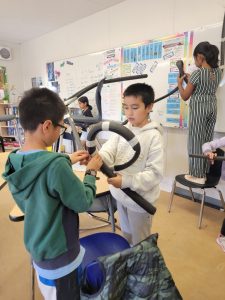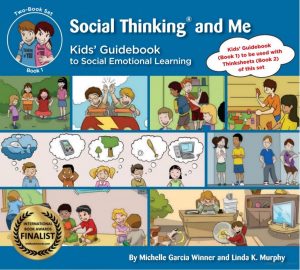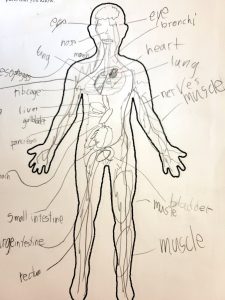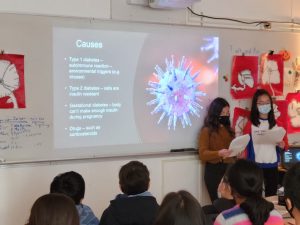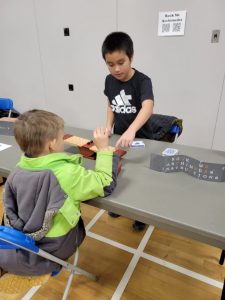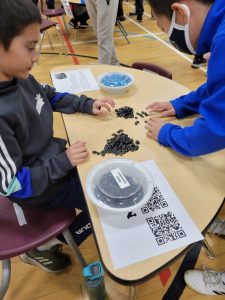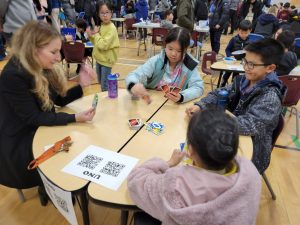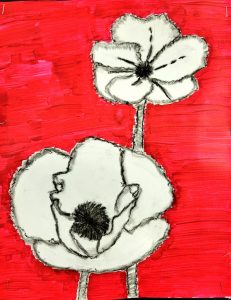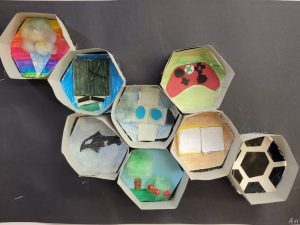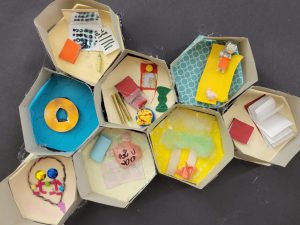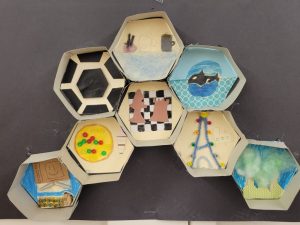MACC TED Talks — Theme of “PASSION”
Hi Everyone!
We will be creating our own TED TALKS under the theme of “Passion” over the next month!
In preparation for this, begin brainstorming ideas about a passion you have that you feel you would like to share with others.
Also, begin watching some TED Talk examples, with live people versus animations, to get ideas about what a TED Talk is. This way, we can discuss it in class when we are together. Here are some possible options that are kid-friendly:
Be thinking of:
- What makes a good TED Talk?
- What will your key problem, question, or topic sentence be to start your talk?
- What evidence will you use to prove your point?
- Is your topic too big for two minutes? Too small?
- Are you passionate about your topic?
- Could you talk about anything you like to do?
- Could you show us anything from home that is important to you?
- Will you need to do any research to find out about your topic?
- Have you thought about what other people who might disagree with you will think? How will you change their minds?
Right now, all you need to do is watch a TED Talk and begin brainstorming ideas. I will let you know of next steps as we are ready.
As we create our speeches, we will be focusing on strong paragraphs, descriptive and persuasive vocabulary, avoiding run-on sentences, and public-speaking techniques. The TED Talk speeches will be given in January, but by the time we go to Winter Break, we will have a very rough draft ready, so we will be ready to refine it when we get back. The speech will be five paragraphs in length. I will be sharing the rubric for performance with you in class.
I look forward to hearing your ideas.
Thank you!
New Unit Term 2 December to January: Our Human Creations
Hello Everyone!
Now that we have finished our first unit on SYSTEMS, we are moving on to discussing the concepts of CREATIVITY and CHANGE!
UNIT TITLE: Our Human Creations, Running Mid-November to Mid-January
CONCEPTS: Change and Creativity
Unit Focus Statement: We use creativity and knowledge together to make innovations that change our world.
An Inquiry Into:
- Our learning and use of creative thinking or creativity
- The design process and being a “maker”
- The impact of technology on humans over time
- Scientific forces and mathematical thinking behind our creations
- How innovations make change
- Change in our lives, perspectives, thinking, and abilities
- Indigenous technologies and their connection to us
- How we can share our creative thinking with one another and the community
Some of the Specific Topics Covered In:
All of this is subject to change or additions as we go, as needed for time and the direction students take it!
Science: Simple machines, Work, Center of Gravity, Technology, Early Indigenous Tools, Deciding which machine has had the greatest benefit/use, making catapults, creating hydraulic devices, Rube Goldberg devices
Socials: Technology and Society — Positive and Negative Impacts, History of Technology, Timelines, Critical Thinking About Our Technology Use, Creation of a Timeline, Debate on Technology
Math: Deeper Conversations around multiplication and division, Use of scientific formulas from physics around work and rate/distance/time, Basic Variables/Algebra, Area/Perimeter, Tiny House Creation, Math Used in Creating Buildings/Skyscrapers through the book “You Do the Math: Skyscrapers”
Language Arts: Ted Talks, Creative Writing, Careful editing, use of non-fiction features in books to do research, organizing notes for research, using key words for internet searches
Applied Design: Hour of Code, Design Process steps used in the creation of catapults, Alternative Use Tests of Creativity, “Perfect Square” structures, as well as further discussions around how creative thinking can be observed, learned, or measured.
French: Selection of one French-speaking country other than France and looking at history of how it came to have French-speaking peoples. Use of French Games. net for French Vocabulary on Greetings and Other Basics
Arts: Maker Projects, Creative-Thinking Challenges, and continued talk about elements and principles of art.
Physical Education and Health: Brainstorming together creative options for cooperative play on the playground. Further Social Thinking discussions. Creating our own games for outside play to share.
Overview Division 5 MACC Grade 4/5, Term One Fall 2023
Hello Everyone!
Report card time! Before we go to Winter Break, you will be receiving the term one report card. In December, we will begin working on term two units — one on CREATIVITY/CHANGE, and the second on EXPLORATION/IDENTITY.
Here is an overview of the many things we did during TERM ONE, FALL 2023.
To tie the big ideas from our curriculum together into a larger, enduring understanding,
we studied all subjects through the lens of a universal, conceptual theme.
We focused on the concept of SYSTEMS
in our unit BODY WORKS.
Unit Focus Statement:
Our personal choices play a role
in how the interconnected system of the human body works.
Core Competency Focus:
Personal Awareness and Responsibility
Critical Thinking
What is the SYSTEM for a great learning community?
(Core Competencies, Socials, Science, PHE, ADST, Career Education)
We spent the first two weeks creating the foundation of a great learning community!
We worked in small teams to design marble roller coasters all over the classroom, discussing both science concepts and what great collaboration looks like during projects.
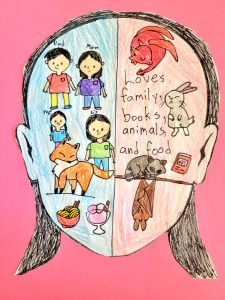 To get to know one another, we created Six Word Memoir Pictures, to communicate some of our interests, strengths, or thoughts to our new classmates. We also did a variety of games and collaborative math challenges and puzzles. We learned how to have class meetings to voice our preferences, concerns, and ideas about classroom activities.
To get to know one another, we created Six Word Memoir Pictures, to communicate some of our interests, strengths, or thoughts to our new classmates. We also did a variety of games and collaborative math challenges and puzzles. We learned how to have class meetings to voice our preferences, concerns, and ideas about classroom activities.
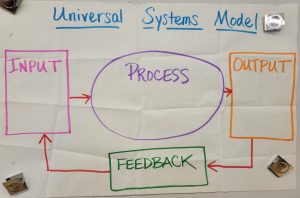 We brainstormed what makes a classroom SYSTEM work well, relating it to the UNIVERSAL SYSTEMS MODEL, an important part of our unit discussions. What do we want to get out of our learning? (output) What do we need to put in to our learning experiences to accomplish our desired output? (input/process)
We brainstormed what makes a classroom SYSTEM work well, relating it to the UNIVERSAL SYSTEMS MODEL, an important part of our unit discussions. What do we want to get out of our learning? (output) What do we need to put in to our learning experiences to accomplish our desired output? (input/process)
To better understand this, we analyzed other systems we know, such as our community and ecosystems. We debriefed our roller coaster activity: What makes an exciting roller coaster work well? (physics, clothoid loops, creativity, speed, etc.) We identified what our classroom would need to be a successful system. Students brainstormed essential agreements and values, which we refer to every day in our work together. What kind of community do we want to build together?
Throughout the term, we focused on the core competencies of personal awareness and critical thinking, which were embedded into each activity and lesson for the unit.
Each week we engaged in social thinking activities as part of our morning Recalibrate Time. This is an opportunity to recalibrate or prepare our thinking as the day starts, so we can have positive relationships and learning experiences at school. We discussed how:
- Looking carefully for social cues helps us find out the expected behaviour in a particular situation,
- Our unexpected behaviour can cause others stress and affect our relationships,
- Our reaction to a problem needs to match the size of the problem,
- Active listening is important to building relationships and involves critical thinking and specific body language,
- Stepping outside of our comfort zone, taking a risk to try something new, is when our best learning happens, and
- Everyone is learning something, we can’t be perfect at all of it, and it is okay to make mistakes or to not know something!
THE HUMAN BODY SYSTEMS!
(Science, Socials, Math, Inquiry Processes, LA)
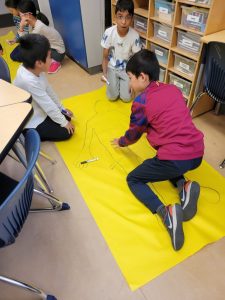 What do you already know about human anatomy? We created life-sized drawings of classmates to identify the inside parts we already knew from our many body systems. We already knew quite a bit, but we needed some more specific information.
What do you already know about human anatomy? We created life-sized drawings of classmates to identify the inside parts we already knew from our many body systems. We already knew quite a bit, but we needed some more specific information.
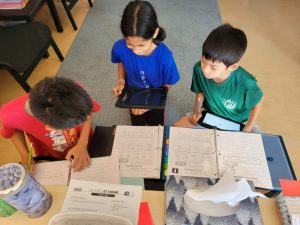 So, we did independent investigation stations! We gathered facts from non-fiction books and online resources like Kids Health, and completed fun experiments about our heart rate, the digestive system length, and the role of saliva in breaking down food, among others.
So, we did independent investigation stations! We gathered facts from non-fiction books and online resources like Kids Health, and completed fun experiments about our heart rate, the digestive system length, and the role of saliva in breaking down food, among others.
We then pretended the Human Body Corporation was having money problems, needed to make budget cuts, and planned to fire one of the many organs in the body! After learning about paragraphs and business letter format, each student chose an organ to research further and wrote a letter to the Corporation with detailed reasons their organ should not be fired!
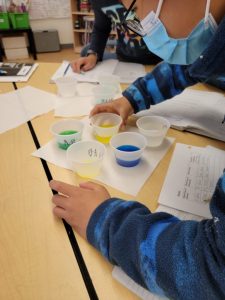
We did experiments to expand our knowledge of germs and how they are spread, and about how blood typing works! Students learned to use the scientific method, to gather data through careful observations, and to analyze results using math and critical-thinking skills.
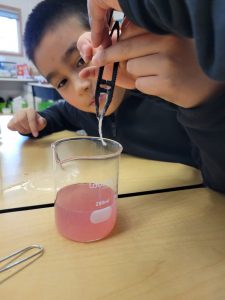 We discussed genetic traits and extracted strawberry DNA, a process which allowed us to learn the role soap plays in bursting the cell membranes of pathogens. There’s a reason to use soap when washing hands!
We discussed genetic traits and extracted strawberry DNA, a process which allowed us to learn the role soap plays in bursting the cell membranes of pathogens. There’s a reason to use soap when washing hands!
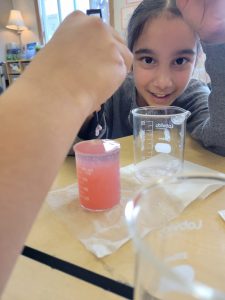 Then, we had discussions about herd immunity, vaccines, epistemology (the diagnosis of diseases), communicable and non-communicable diseases, and some of the personal choices we can make to help prevent disease.
Then, we had discussions about herd immunity, vaccines, epistemology (the diagnosis of diseases), communicable and non-communicable diseases, and some of the personal choices we can make to help prevent disease.
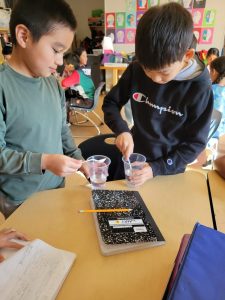 Our lab on “patient zero” allowed us to see how germs are spread quickly in a group!
Our lab on “patient zero” allowed us to see how germs are spread quickly in a group!
Finally, we tested a variety of sites in the school and grew germ colonies in petri dishes. We made careful observations, gathered and analyzed data, and crunched the numbers to determine the probability of having touched a bacteria, yeast, mold, or fungus. We used math to help us make some positive personal choices to prevent the spread of germs.
During all experiments, we used critical-thinking to ask questions and make conclusions, and we used personal awareness to work with others collaboratively and safely.
At the end of the unit, each student chose a disease to investigate further with a partner. They learned how to find information, take research notes, and present their information to the class in a PowerPoint presentation and speech. Afterwards, they used their new found knowledge, pretending to be a group of doctors with other students, and helping diagnose mystery diseases presented by Ms. D.
What helps the body system work well?
(Socials, Science, PHE-Health, Math, Career Education, Language Arts):
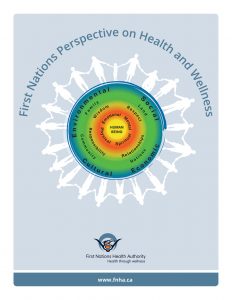 To make our SYSTEM of the human body function effectively, we need to be aware of the INPUTS we put into our body. What are the personal choices we can make that help us to be healthy? Students looked at informational graphs, watched TED talks, and listened to a variety of perspectives about good health to learn how to make positive food and environmental choices.
To make our SYSTEM of the human body function effectively, we need to be aware of the INPUTS we put into our body. What are the personal choices we can make that help us to be healthy? Students looked at informational graphs, watched TED talks, and listened to a variety of perspectives about good health to learn how to make positive food and environmental choices.
This included exploring the Indigenous Health and Wellness Model to discuss holistic aspects of health, such as the relationship between good health and your connection with family and community. Students looked at Indigenous Medicine Wheel models and reflected on the emotional, physical, mental, and spiritual things that contribute to our good health.
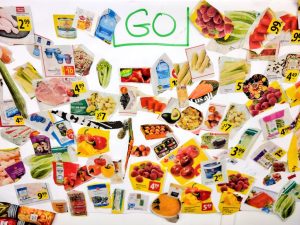 How does what and how we eat affect our bodies and health? We discussed mindful eating during lunch, which means having presence while eating and becoming aware of the eating experience. If we slow down, we taste more of the food and allow our digestive system time to do its job properly!
How does what and how we eat affect our bodies and health? We discussed mindful eating during lunch, which means having presence while eating and becoming aware of the eating experience. If we slow down, we taste more of the food and allow our digestive system time to do its job properly!
Students also brought in some favourite snacks and analyzed ingredients lists and the math on food labels to better understand the nutritional value of processed foods. We sorted foods into categories of GO, SLOW, and WHOA to better understand how much of certain foods we can have based on their nutritional content.
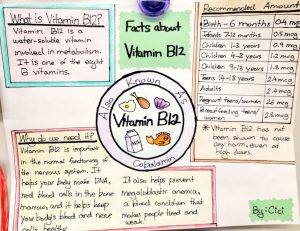
We also studied the impact of vitamins and minerals on the body. Each student chose and conducted research about a vitamin or mineral and its impact on the body. They then created informational posters with facts to share with their classmates.
Gut Bacteria and Artificial Intelligence!
(Science, ADST, PHE, Technology, Math Computational Thinking)
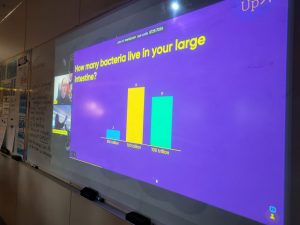 As we explored nutrition, we learned about our second brain located in our gut! Ever feel “butterflies” in your stomach or lower guts before you have a test? That’s your gut brain! Inside our gut are many healthy bacteria helping us with the digestive process. We discussed the strong connection between having a healthy gut microbiome and our overall physical and mental wellness.
As we explored nutrition, we learned about our second brain located in our gut! Ever feel “butterflies” in your stomach or lower guts before you have a test? That’s your gut brain! Inside our gut are many healthy bacteria helping us with the digestive process. We discussed the strong connection between having a healthy gut microbiome and our overall physical and mental wellness.
Through Science World’s Tech-Up Program, we had an in-class workshop about gut bacteria! We learned about the different types of gut bacteria, what conditions in our gut cultivate healthy bacteria, and how we can take care of our microbiome by getting proper sleep, managing our stress, only taking antibiotics when needed, and eating healthy foods including fibre and green, leafy vegetables.
Then, we learned about the language of artificial intelligence chatbots, natural language processing. As a class, we programmed an AI Chatbot to answer questions as if it was a specific gut bacteria! This involved some basic coding, computational thinking, and identifying the specific information the AI would need in order to respond. We had great discussions about how AI could be helpful, as well as the ethics needed to use it responsibly. We look forward to doing more coding in December as part of the Hour of Code!
Mental Health & Self-Expression
(Socials/Science/PHE/Career Ed/Fine Art/LA):
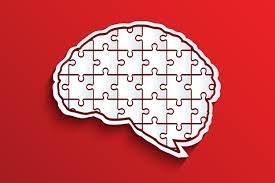 Students explored the connection between our mental health and physical health.
Students explored the connection between our mental health and physical health.
As we played a variety of active games in the gym, we explored how to monitor our heart rate and identified the value of daily exercise and getting the appropriate amount of sleep!
We discussed brain structure and how emotion impacts higher thinking, so we can better understand how we self-regulate in times of stress. We learned the function of the main parts of the brain, including the amygdala, pre-frontal cortex, and hippocampus. We had great discussion about how it is hard to make rational decisions when one is emotional, so it is important to find self-regulation strategies to calm the brain before taking action.
 We tried many self-regulation strategies in class, including daily mindful breathing, practicing gratitude, taking time outside to get fresh air or take a walk, and using the class break board to reset our thinking and bodies during longer work periods.
We tried many self-regulation strategies in class, including daily mindful breathing, practicing gratitude, taking time outside to get fresh air or take a walk, and using the class break board to reset our thinking and bodies during longer work periods.
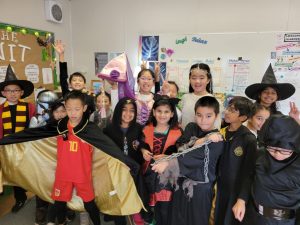 We watched the TED talk “How to Make Stress Your Friend” and discussed how not all stress is bad. We learned that managing stress and being connected with your community contributes to long life. In gym we did yoga to explore how stretching and focusing our breathing can help with stress management. We surveyed our peers and made graphs to represent all of the ways we manage our daily stress in positive ways.
We watched the TED talk “How to Make Stress Your Friend” and discussed how not all stress is bad. We learned that managing stress and being connected with your community contributes to long life. In gym we did yoga to explore how stretching and focusing our breathing can help with stress management. We surveyed our peers and made graphs to represent all of the ways we manage our daily stress in positive ways.
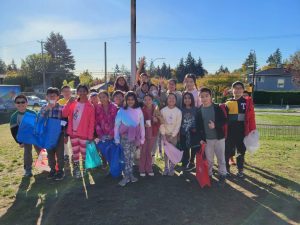
Part of mental health is building connections with others. We practiced this through class meetings, free choice times, playing games, organizing classroom decorations for holidays, and doing Suncrest activities together such as the Pumpkin Patch!
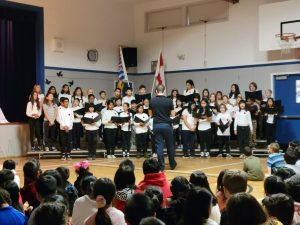 Many students also chose to be involved in Suncrest extracurricular activities, such as the Cross Country team, Chess Club, Intermediate Choir, or our Family Math Games Night. Thank you Division 5 for all of your contributions to the greater community!
Many students also chose to be involved in Suncrest extracurricular activities, such as the Cross Country team, Chess Club, Intermediate Choir, or our Family Math Games Night. Thank you Division 5 for all of your contributions to the greater community!
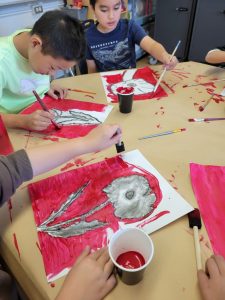 Creativity is an important tool for mental health, and we had many conversations in the classroom about the positive feelings we have when making something!
Creativity is an important tool for mental health, and we had many conversations in the classroom about the positive feelings we have when making something!
We created beautiful poppy paintings for Remembrance Day, applying elements and principles of art such as colour, emphasis, and negative space.
We also created HIVE art, using mixed media to represent people, places, and things that bring us strength and help us thrive. A bee hive is strong, and so is the community we build around us!
Gathering and Communicating Data
(Math, Science, PHE, Career Education, Language Arts):
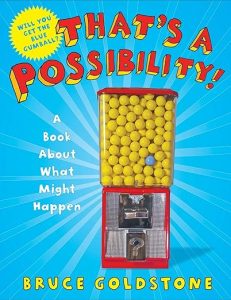
We played many probability games, read the entertaining book It’s Possible, discussed the language referring to probability, and through experiments discovered the difference between experimental and theoretical probability. This involved discussion of basic fractions, decimals, and how to find percentages.
We applied this math to our germ lab to express the probability of touching pathogens in locations throughout the school. This is an example of how math knowledge can help us make personal choices that impact our health in positive ways.
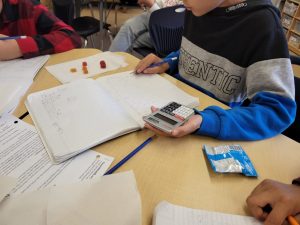 We used the NY Times Learning Network to look at different types of graphs about nutrition, climate change, and blood sugar levels. We practiced two questions to increase our critical thinking and observation skills, “What do you notice?” and “What do you wonder?” We identified essential parts of a graph and how graphs communicate data.
We used the NY Times Learning Network to look at different types of graphs about nutrition, climate change, and blood sugar levels. We practiced two questions to increase our critical thinking and observation skills, “What do you notice?” and “What do you wonder?” We identified essential parts of a graph and how graphs communicate data.
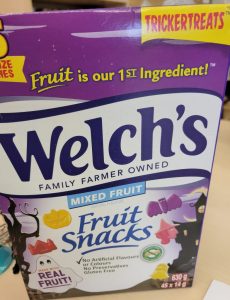
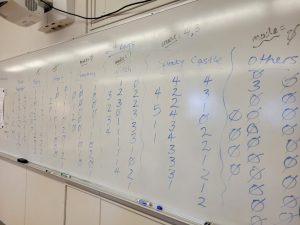 We also practiced gathering data, whether about ourselves, genetic traits, or class preferences.
We also practiced gathering data, whether about ourselves, genetic traits, or class preferences.
We learned to analyze data using measures of central tendency such as mean, median, mode, and range, then applied these skills as we pretended to be consultants analyzing Halloween Welch’s gummies packages for a fair distribution of colours and shapes.
There are SYSTEMS for communicating, finding, and documenting information! (Language Arts, Socials, Science, French)
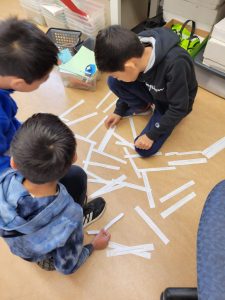 Throughout all subjects, we used language arts curricular competencies, whether it was to analyze news articles and non-fiction resources, to communicate information in graphics and speeches, or to do research on diseases or nutrition.
Throughout all subjects, we used language arts curricular competencies, whether it was to analyze news articles and non-fiction resources, to communicate information in graphics and speeches, or to do research on diseases or nutrition.
We read a variety of non-fiction articles from Kids Health, learned to take research notes by identifying key ideas, identified criteria for finding appropriate resources online, and discussed ways to better present our ideas in clear, organized, and/or persuasive ways.
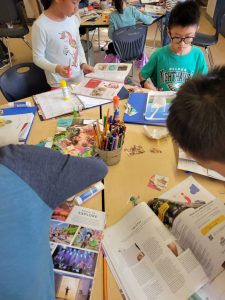 We learned about personal and business letter formats, and we discussed how to make a strong, organized paragraph. We strengthened our writing by adding creative vocabulary and looking for ways to express ideas in ways that inspire others.
We learned about personal and business letter formats, and we discussed how to make a strong, organized paragraph. We strengthened our writing by adding creative vocabulary and looking for ways to express ideas in ways that inspire others.
We talked about what makes an effective speech, and how to be a respectful active listener in the audience. We also discussed how to add detail to our e-portfolios to better communicate ideas and our learning.
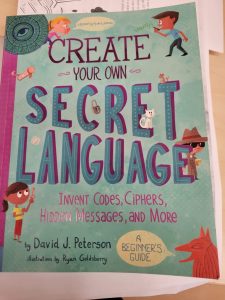 We also looked at the SYSTEM or CODE behind all human languages, and began the process of creating one of our own for fun!
We also looked at the SYSTEM or CODE behind all human languages, and began the process of creating one of our own for fun!
We look forward to continuing our learning about writing in term two!
French:
As part of this discussion of the system of languages, we began our French studies for the year. We practiced some basic French with one another using songs and conversation with peers.
Students were encouraged to learn basic greetings, colours, and numbers, as well as some basic vocabulary for parts of the body in connection with our unit. They also created small posters to show their learning and did mini dialogues with peers to practice.
Students with French fluency were encouraged to read French articles in magazines we have in the classroom, and to write information about them in their journals.
Putting Learning Together in a Creative Way!
(ADST, Science, Socials, Math, PHE, Language Arts, Core Competencies)
 We ended the term synthesizing our knowledge of SYSTEMS, and then showing our understanding of how personal choices impact the human body through the creation of a fun game to play with peers.
We ended the term synthesizing our knowledge of SYSTEMS, and then showing our understanding of how personal choices impact the human body through the creation of a fun game to play with peers.
The goal was to include material from all of the subject areas we discussed as part of this unit on SYSTEMS and PERSONAL AWARENESS.
Students had a lot of fun using applied design skills to create unique and interactive games! We plan to share our games with our buddies in Ms. Silva’s class.
Overall, it was an amazing term! We invite you to see student reflections about their work, documented in their e-portfolios and report cards.
E-Port #5 HIVE ART
This is an easy e-port just to do a quick reflection on your HIVE Art project from class.
TITLE: HIVE Art
Question:
In a paragraph, please explain the sections of your HIVE art. You were asked to represent eight things you believe help you to thrive as a person, providing you with strength. Please tell me what they were and why? One sentence per section of the HIVE is required, so minimum 8 sentences. You may do more if you wish, but do not have any more than 16 total sentences, please.
**Please make sure to include a clear photo of your HIVE art project.
E-Port #4: Probability
Title: Probability
Questions:
What is probability and why do you think we learn about it?
Explain why the probability of something is between zero and one on a number line.
Name four words associated with probability and what they mean.
Is Rock, Paper, Scissors a fair game?
What is the difference between theoretical and experimental probability?
If I chose a random student from the class, what is the probability they would have a zuma chair for the day? (give fraction, decimal, and percentage)
If I chose a random student from the class, what is the probability they would be at table four? (give fraction, decimal, and percentage)
If I chose a random student from the class, what is the probability the person would be you? (give fraction, decimal, and percentage)
Make up another “random student” choice from our class and give me the probability of that choice. (fraction, decimal, and percentage)
End of Systems Unit Fall 2023: ADST Game Project
Hello!
Final assignment for our first unit of the year! Report Cards are coming up fast for the end of term one!
Students will be put in groups to create a game to teach people how their personal choices are connected to the health of their body.
The game needs to:
- Show your knowledge from the unit, so you need to use your binder and journal as a resource,
- Teach someone in grade 3 or higher how they can make positive personal choices that help the interconnected system of the human body (we will play the games with our buddy class),
- Be a board game or 3-dimensional game (try to avoid having a game with too many cards, as they take a long time to make — no games that are cards only, as this is an ADST project and needs to involve building),
- Have a winner for the game after less than 30 minutes of play,
- Be easy to explain and play right away, rather than having a ton of instructions,
- Include a set of instructions and all playing pieces,
- Be attractive and aesthetic so people will WANT to play the game (we will look at some examples in class), and
- Be finished and ready to play by December 5th, Tuesday.
Here are the steps to make the game:
Step One Make up a theme for the game and think about how you will teach what we have learned in the unit about personal choices. We will brainstorm some themes together in class, so feel free to use one of those or make up your own.
Step Two Create the rules of the game. Write them down as a draft in your journal, then someone in your group needs to type them up.
Step Three Look at materials we have available, or what materials you could bring from home like cardboard and recyclables. Do not purchase anything to make the game. use existing materials. Think about how much time you have to build. Then, make a draft of what the game will look like in your drawing book and create a list of the materials you will need to gather. I can provide dice, timers, and some spinners, if needed, and we have a lot of items that can serve as play tokens, so again, no need to purchase anything new.
Step Four Make the game. As you find issues with construction, don’t worry about changing your idea, but keep track of how much time you have to build so it is finished on time and meets criteria.
Step Five Add playing pieces and think about how to store the game so pieces are not lost. Can you create an aesthetic way to store the game?
Step Six Find someone to play the game with. Have them evaluate your game. Evaluate yourself on the rubric I provide for you. Turn the rubric in to Ms. D. Play the game with our Buddy Class.
Tips and Ideas:
- Always remember simple is better. If a game is easy, it will be more fun to play.
- Add a start and a finish space.
- Borrow ideas from other games and make them better – don’t just copy, but do use ideas you have seen before and morph them into your own!
- Add spaces where you have to draw a card, but do not make too many cards. This is one thing that generally takes too much time. What other ways can you communicate health information in the game, other than using cards and written facts?
- Do a few test plays by yourself to see if it is too hard or needs adjustment.
- Cut small figures out of paper to use as game pieces, or use Legos, etc.
- Get ideas from other people. Creativity doesn’t just come from one person. The best ideas are ones that involve lots of ideas.
- Make it colorful and eye-popping. Make it 3D! It doesn’t need to be too big, though. Think about the size of most board games we play.
- Name it something appealing! Come up with something of your own – don’t use a name out of a movie or comic book.
- You could have an objective or goal of the game, instead of a finish space to reach, such as find a golden nugget or land on the water fountain 10 times.
- For the base of the game you can ask for a clean take out pizza box from a restaurant or find a box at home from Amazon. Any supplies from home are also okay, as long as Mom and Dad are okay with it! No need to purchase anything new.
A rubric will be provided to self-assess at the end of the project. The project is due by December 5th, Tuesday. No extensions due to report card timeline!!
Social Emotional Learning: Perfectionism and Doing Work Myself!
 Today we read the book Creepy Crayon by Aaron Reynolds, with illustrations by Peter Brown.
Today we read the book Creepy Crayon by Aaron Reynolds, with illustrations by Peter Brown.
In the book, the main character, Jasper Rabbit, is struggling with school work, but then finds a perfect purple crayon that does all of the work for him! Jasper suddenly starts getting top marks on everything!
At first, it feels great, but then the crayon starts taking over Jasper’s life. The crayon even changes work Jasper was already proud of, coming behind him and re-doing everything so it is all in purple and perfect! Jasper feels badly about this, so he gets rid of the crayon and starts doing all of his own work. It isn’t perfect, but he feels much better about it being his own!
After reading the book, we discussed how there are many of us, as advanced learners, who really want all of our work to be perfect all the time. Sometimes as we strive for perfection, we look to outside resources to do the work for us. For example, we might use the internet or artificial intelligence, and ask it to do our work instead of doing our own writing. Or, we may ask others for help, and out of our worry to be perfect, we allow those people to change our work. This means the work becomes more “their work” and not representative of our own abilities.
It is okay to ask for help, but we also need to be willing to work on it by ourselves, because the struggle, the making of mistakes, is when we do our best learning!
I gave the class an example that was kind of silly. Ms. D does not feel “proficient” at soccer (mainly because it isn’t something I have put much thought into, really). But what if, rather than accepting my proficiency, I wanted to appear perfect. So, I hired a student who is amazing at soccer to wear my jersey and represent me on the field. They would do an amazing job, and then afterwards, I would take all the accolades and the trophy! This seemed ridiculous to everyone, and I agreed. If I want to get better at soccer, then I can certainly make some choices to develop my skills!
Also, being better doesn’t mean I need to be PERFECT at it. For example, if I want to be better at soccer, I don’t have to be a top soccer star on the field. I really just want some skills to be able to join friends in a game. So, I can be realistic about what I want in life. It isn’t possible to be top notch in everything. That is okay, because I am going to make the choice of where I want to put my time. I can play soccer with my friends without needing to always win or be the top player.
I shared with everyone this is why I also have them fill out rubrics for self-reflection before I give any feedback. The research shows, people are more likely to follow through on goals they make for themselves, or on their own self-reflection, more than they would follow up on what someone else tells them to do. For example, someone might tell you to clean your room a million times, and you may or may not choose to clean it (generally, I imagine, most of Division 5 doesn’t do this without supervision!) But, if you choose to have a cleaner room because you see the value of having a clean space to work and live and sleep in, well, you are more likely to work on the skills it takes to keep a clean room.
Finally, grade 4 and 5 are great practice years. We can make lots of mistakes because we are learning how to be independent self-managers. Developmentally, we are still working on personal awareness of one another, determining what our interests are, and learning how to make friends. Be willing to make mistakes! And, also know, none of the marks you receive at this point in your learning journey will stay with you when you move on to high school or college. And when you get to my age, no one cares about what you did in high school or college. With time, mistakes are just learning. We always move on from them.
I know, deep thinking for a Monday! I hope everyone takes time to talk about these things at home. More to come on social-emotional thinking in future posts.
Kindly,
Ms. D
Assessment Reminders & Life Rubric Activity for Home
Hello Everyone,
Today, I would like to talk about assessment and the LIFE RUBRIC activity we did in class.
Some thoughts about assessment, as I shared in email to you all:
- The goal is to get proficient; extending is reserved for going beyond criteria and grade-level expectations in specific ways.
- To get a developing on anything does not mean a person is having trouble or needs any serious intervention at this time unless I contact you (because I would if it was needed). It means they are still developing and need special encouragement in that area.
- Please review project rubrics you receive, then sign and return immediately to school. I track who has brought them in so I can be sure you have seen them. In this way we avoid surprises on the report card, and everyone gets communication about progress.
- Projects involve more than one subject. As appropriate, depending on curricular competencies, I divide up the marks for a project between subjects, noted at the top of the rubric. For example, the Nutrition Poster involves language arts presentation and research documentation skills, socials research competencies, and science/health content from nutrition information.
- All e-port marks contribute to language arts evaluation, as well as unit content in socials, science, and math.
- You will note sometimes I indicate a mark with a slash. This means your child is between areas. I always note the stronger area of the proficiency scale first. For example, if I say PRF/EXT, it means the student was stronger on the proficient side, but they had some elements of extending.
- For report cards I can only assign one proficiency scale mark per subject, so I gather information from all daily assignments, projects, and e-ports to make that decision. It is not an average of proficiency scale marks but based on the picture of child’s progress to date at the end of the term. I encourage you to read my feedback, report card comments, and student goals on the report, rather than just the marks, to get a better picture.
- Please see your child’s e-ports and make comments if you have time. At the end of the term, I will be giving you a questionnaire to fill out about how you think your child is doing, so I can take your input into mind.
- Binders have daily work that has been passed back with checks. Some students are also missing work. While I don’t have time to go through and chase every single learning assignment down, any student is welcome to ask me in class if they are missing something. Students will be asked to reflect at the end of term one how they have been doing on turning in assignments, as their input is also required for the report card.
- A reminder that everyone responds better to hearing strengths first, and then 1-2 areas of feedback for next time. It is overwhelming to hear too much. This is especially true for advanced learners who frequently struggle with perfectionism and unrealistic expectations about performance. We can accidentally encourage their tendency to catastrophize about the importance of one mark by talking about an assignment or project for too long when it comes home. Everyone will have many more opportunities to practice and learn things they are still working on. One project is just one step in the journey.
Today, we reviewed the words associated with the proficiency rubric to ensure we all understand them.
I often say that the proficiency rubric is easier to understand, with its words of emerging/developing/applying (proficient)/extending if you create a LIFE RUBRIC.
Think of one thing that you do daily. We assigned the four parts to the four corners of our classroom. Then, Ms. D said an activity and students moved to the part of the rubric they thought they were in.
For example, where are you on “cleaning your room?”
EXTENDING — I can clean my room independently and use sophisticated skills, some of which I learned on my own time, such as feng shui arrangements, Marie Kondo folding, organizing boxes I created myself, to clean it. No one needs to tell me to clean my room. I could teach someone else how to clean a room, and I probably remind other people to “get to it!” I even developed my own personal schedule for cleaning and posted it on the fridge.
PROFICIENT — I can clean my room independently and use a complete set of skills I have been taught to organize it — for example, vacuuming, making my bed, and picking up materials to put into organizing buckets I have been given. No one needs to check in on me as I am cleaning my room. I feel confident doing it myself.
DEVELOPING — I can clean my room myself with some guidance. For example, someone might need to check in on me and say, stop reading and get to cleaning! Or, maybe I need help getting the vacuum out and turning it on. Maybe I need some advice on how to fold corners on the sheets. But, I have a partial understanding of what to do and can do some of it myself.
EMERGING — I either have never cleaned my room before, or I can clean my room with a lot of guidance, as I am beginning to learn how to do it. I might need assistance deciding when the room is dirty, staying on task and not making new messes while cleaning it up, or not shoving dirty laundry under the bed and instead putting it in the hamper. My parents are showing me how the vacuum works, as I haven’t done that before. My parents came in and modelled for me how to clean, talking about the steps as they helped me, so I can learn how to do it next time on my own.
**Try this at home as a discussion. Try something like — making your own lunch, making dinner for the family, riding a bicycle, coming up with a family activity, or playing with a sibling. It works best if BOTH parent and child identify some things they do on the LIFE RUBRIC, so everyone can see they aren’t alone in developing skills. We are all doing it, and it is a lifelong process.
Diseases PowerPoint Project!
Hello Everyone!
We have been talking together about germs and pathogens, and what we can do to keep the body healthy!
To further explore this area, with a partner, students will create a PowerPoint presentation together.
First, do some research on a disease of their choice. Research is due by Tuesday, November 7th. Here are the guidelines for choosing and researching a disease:
- It needs to be a common communicable or non-communicable disease. We are not doing disorders or conditions.
- Your choice needs to be approved by Ms. D before starting research.
- The disease needs to be one that you would be more likely to get due to personal choices (nutrition, hygiene, exercise, etc.) so you can talk about how not to get the disease by making healthy choices we have discussed in class.
- Please look on the Articles of Interest on the blog for website suggestions, or use legitimate websites per our discussion in class.
- If you can’t understand an online article, and it has vocabulary words you can’t understand on your own, then use a different article at your reading level.
- If you have questions about whether a website is safe, please ask Ms. D.
- Keep notes in your journal using our note taking chart method.
- No formal bibliography is needed for this presentation, but I would like you to record where you found your notes in your journal.
What do you need to find out about the disease? Each of these things can be one slide in your PowerPoint presentation, for 10 slides maximum and total PowerPoint due November 14th, Tuesday:
- Slide 1 — Introduction: Name of the Disease, and your name as author
- Slide 2 — What is it? Does it have more than one name?
- Slide 3 — How long have we known about this disease? Who discovered it?
- Slide 4 — What causes it? Is there a specific virus, bacteria, or pathogen that is involved? What does the pathogen look like under the microscope if one is involved?
- Slide 5 — What are the symptoms of the disease? How would I know I have it? What tests would have to be done to find out?
- Slide 6 — Who usually has the disease?
- Slide 7 — What treatments or cure are there for this disease?
- Slide 8 — How can I prevent getting this disease? What specific lifestyle or personal choices will help?
- Slide 9 — Summary Slide, 5 key points or takeaways you want everyone to remember.
- Slide 10 — Concluding Slide, “Are there any questions?”
We will use PowerPoint to do this project and to Present:
For many grade fours, this is a new presentation method, and your goal is to learn how to create a slide with a picture, title, and bullet points. We will practice in class.
For grade fives who were with me last year, the focus this year is to make your slideshows more aesthetic and effective. We will focus on how to use fonts, colours, pictures, and organization to make them more effective!
We will then present our PowerPoints to the class using a short script. Script and presentations due November 16th.
Here are the evaluation criteria for this assignment:
- Please do 10 slides for your presentation as described above.
- Share the responsibility with your partner.
- Each of you can do either the intro or the last slide.
- Split up the other 8 slides between you.
- One person creates the PowerPoint and then shares between you on One Drive.
- Don’t edit any slide that isn’t your own to do. If you have input on your partner’s slides, make sure you talk to them first.
- Use one of the set themes in PowerPoint for all of your slides.
- Make sure the font you use for titles and bullet points is an appropriate size for presentation AND stays the same type for all slides.
- Use bullets and shortened phrases to present information, not paragraphs. Do not use too much text.
- Put a picture on each slide. Pictures need to be related to what you are talking about, not silly pictures, smiley faces, or cartoons.
- Do not use pictures that have copyright marks on them. If you don’t know how to tell, you can ask Ms. D.
- Do not use emojis. At all.
- Avoid using really bright colours such as red, yellow, or bright blue for text.
- Keep text in dark, easy to read colours.
- Don’t use a black, red, or orange background, as this can be hard to look at.
- Don’t have a last slide that says, “Bye!” or “Thank you for watching!” It can say “Are there any questions?” and have a picture related to your presentation.
- Make a script for your PowerPoint with what you would like to say for each slide. Don’t just repeat your bullet points. Add information here.
- Limit your whole presentation to 5 minutes or less.
- Practice in front of someone. It does not need to be memorized, but it does need to be well practiced.
I look forward to seeing your presentations!

